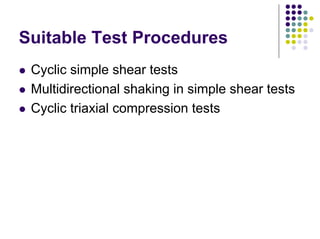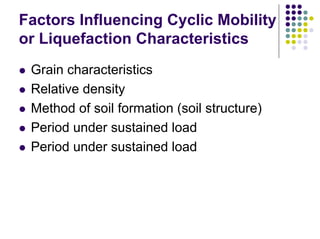Cyclic Test
- 1. Cyclic Behavior of Sand and Cyclic Triaxial Tests Hsin-yu Shan Dept. of Civil Engineering National Chiao Tung University
- 2. Causes of Pore Pressure Buildup due to Cyclic Stress Application Stress are due to upward propagation of shear waves in a soil deposit during earthquake Structure of the cohesionless soil tends to become more compact Transfer of stress to the pore water Reduction in stress on the soil grains
- 3. Soil grain structure rebounds to the extent required to keep the volume constant Volume reduction and soil structure rebound determines the magnitude of the increase in pore water pressure increase As the pore water pressure approaches a value equal to the applied confining pressure the sand begins to undergo deformations
- 4. If the sand is loose: Pore pressure increase suddenly to a value equal to the applied confining pressure The sand will rapidly begin to undergo large deformations with shear strains exceeding around 20% or more If the sand will undergo unlimited deformations without mobilizing significant resistance to deformation it can be said to be liquefied
- 5. If the sand is dense: It may develop a residual pore water pressure (a peak cyclic pore pressure ratio of 100%) When the cyclic stress is reapplied on the next stress cycle, or if the sand is subjected to monotonic loading The soil will tend to dilate Pore pressure will drop if the sand is undrained The soil will ultimately develop enough resistance to withstand the applied stress Large deformation will develop during the process
- 6. Effect of Partial Drainage There will be some drainage in the field Add some margin of safety against cyclic mobility or liquefaction To ignore the effect of partial drainage is on the conservative side
- 7. Evaluating Liquefaction or Cyclic Mobility Potential Methods based on observation of performance of sand deposit in previous earthquake Method based on stress conditions in field and laboratory determinations of stress conditions causing cyclic mobility or liquefaction of soils
- 8. Observation Method Based on the location of the points representing the data set (N1, τ/σ’0) relative to the curve representing the lower bound for sites where liquefaction occurred N1 is the corrected SPT-N value 0σ τ ′ = cyclic ratio causing liquefaction
- 9. d av r g a 0 0max 0 65.0 σ σ σ τ ′ ≈ ′ amax = maximum acceleration at the ground surface σ0 = total overburden pressure on sand layer under consideration σ’0 = effective overburden pressure on sand layer under consideration rd = a stress reduction factor varying from a value of one at the ground surface to a value of 0.9 at a depth of 10 m
- 10. Experience with the Method The lower bound curve is strongly supported by abundant data from Japan and China Works satisfactorily with the data from 921 earthquake Conservative for earthquakes with lesser magnitudes involving shorter duration of shaking
- 11. Limitations of the Method Need for additional reliable data points to better define the lower bound of causing cyclic mobility or liquefaction at high values of τav/σ’0 Need to understand more about the significant factors affecting cyclic mobility or liquefaction Duration of shaking, magnitude of earthquake
- 12. Penetration resistance may not be an appropriate index of the cyclic mobility characteristics of soils The standard penetration resistance of a soil is not always determined with reliability in the field and its value may vary significantly depending on the boring and sampling conditions
- 13. Factors Affecting the Cyclic Mobility Characteristics of Sand Density or relative density ↑ Grain structure or fabric ↑ Length of time the sand subjected to sustained pressures ↑ Value of K0 ↑ Prior seismic or other shear strains ↑
- 14. Factors Affecting the N Value The use of drilling mud vs. casing for supporting the walls of the drill hole The use of a hollow stem auger vs. casing and water The size of the drill hole The number of turns of the rope around the drum
- 15. The use of a small or large anvil The length of the drive rods The used of nonstandard sampling tubes The depth range over which the penetration resistance is measured
- 16. Evaluating Liquefaction or Cyclic Mobility Potential Methods based on observation of performance of sand deposit in previous earthquake Method based on stress conditions in field and laboratory determinations of stress conditions causing cyclic mobility or liquefaction of soils
- 17. Methods Based on Field/Lab Stress Conditions An evaluation of the cyclic stresses induced at different levels in the deposit by the earthquake shaking A laboratory investigation to determine the cyclic stresses which, at given confining pressures representative of specific depths in the deposit, will cause the soil to develop a peak cyclic pore pressure ratio of 100% or undergoes various degrees of cyclic strain
- 18. Compare the results of the two evaluation: The cyclic stresses induced in the field with the stresses required to cause a peak cyclic pore pressure ratio of 100% An acceptable limit of cyclic strain in representative samples in the lab
- 19. 5 Basic Procedures Need to be Developed Suitable analytical procedures for evaluating stresses developed in an earthquake Suitable procedure for representing the irregular stress history produced by the earthquake by an equivalent uniform cyclic stress series Suitable test procedure for measuring the cyclic stress conditions causing a peak pore pressure ratio of 100% or intolerable level of strain in the soil sample
- 20. Understanding of all the factors having a significant influence on the cyclic mobility or liquefaction characteristics of soils Understanding of the effects of sample disturbance on the in-situ properties of natural deposits
- 21. Methods for Evaluating Stresses Induced by Earthquake Shaking Ground response analysis that neglects the pore pressure buildup Procedure that takes into account the pore pressure generated in the soil Simplified procedure based on a knowledge of the maximum ground surface acceleration Deconvolution of a known ground surface motion
- 22. Ignoring pore pressure build up during earthquake may not be particularly significant May lead to somewhat conservative results in some cases
- 23. Converting Irreg. Stress His. into Equiv. Unif. Cyclic Stress Series Because it is usually more convenient to perform lab tests using uniform cyclic stress applications than to reproduce the actual field stress history There were three methods can be used and their differences have little effect on the final results
- 24. Three basic methods: By estimation from a visual inspection of the irregular time history involved By a weighting procedure for individual stress cycles – use an experimentally-determined pore pressure response A cumulative damage approach based on Miner’s law and involving the natural period of the deposit and the duration of earthquake shaking
- 25. Suitable Test Procedures Cyclic simple shear tests Multidirectional shaking in simple shear tests Cyclic triaxial compression tests
- 26. Cyclic Direct Simple Shear DSS Roscoe-type Four plates Pure shear is applied to horizontal and vertical plane Difficulties Preparation of representative samples Development of uniform shear strains throughout the samples Application of uniform stress conditions Avoidance of stress concentrations
- 27. Very long and shallow samples Stress concentrations are limited to small areas at the ends Longer samples less affected by the stiffness of the walls of the sample container
- 28. Cyclic Triaxial Compression Tests Equipment less complicated and more available than DSS Do not reproduce correct initial stress conditions for NC soils or in a simple shear test
- 29. Other limitations Stress concentrations at the cap and base A 90° rotation of the direction of major principal stress during the two halves of the loading cycle Necking may develop and invalidate the test data beyond this point in the test Intermediate principal stress does not have the same relative value during the two halves of the loading cycle Difficult to achieve a high degree of accuracy for stress ratio not representative of field values
- 30. Cyclic triaxial stress ratio is higher than that for simple shear condition triaxial3shearsimple 2 = ′ σ σ σ τ dc r c h c cr = correction factor ranging from 0.5 – 1.0, increases with K0
- 31. Factors Influencing Cyclic Mobility or Liquefaction Characteristics Grain characteristics Relative density Method of soil formation (soil structure) Period under sustained load Period under sustained load
- 32. Previous strain history Increase the stress ratio Lateral earth pressure coefficient and overconsolidation Larger K0 higher stress ratio Cyclic mobility and liquefaction characteristics of in-situ deposits Disturbance lower the stress ratio































